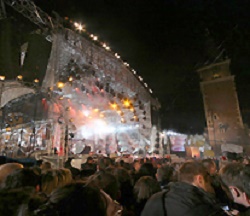
Reflection & Refraction
Have you ever gone to a lake and skipped flat stones across the water’s surface? It is all about velocity and angle of incidence. Too slow and under the water the rock goes, while too steep of an angle will cause the rock to dive in the drink as well.
Well, funnily enough, our “rock” does a similar thing. And though our rock is music, the sound waves actually skip as well, but instead of a lake, they bounce off human heads and a thermal layer.
Where do we get a thermal layer in a rock show, you ponder? Well, there could be 5,000 happy dancing heater humans forming a pool of warmth right in front of the loudspeakers.
Sound already has the velocity part built into it as it travels at around 1,200 feet per second, so that leaves angle of incidence. Recite the mantra “We will fly the PA, we will fly it every day!” This is to be sung with the emphasis on the word “fly”.
Flying the PA means hanging it from the ceiling versus the less desirable alternative of stacking it on a riser. The two main reasons to fly: it helps with sight lines, and it improves the angle of incidence to a steeper angle.
Unlike throwing rocks skipping across a lake, we do not want our sonic rock to skip over the heads of our heater humans. By hanging the PA way up high, it improves the ability for the sound to penetrate that thermal layer and please the desiring ears below. But does sound really bounce off of the thermal layer created by humans? Sort of.
Actually, there are several things occurring that all combine in varying levels to create, for our purposes, the same outcome. The sound bouncing off of the actual hard human heads seems the most obvious, and standing a bit taller you can notice that difference.
If the audience is sweaty enough to create a denser and more humid region around them than the air farther above, then some sound that reaches that layer will bounce, upwardly deflected, not too dissimilar to the rock bouncing off of the lake.
Another cause of the bounce, and what I think is the most interesting, is refraction, but this is a velocity issue that I will discuss in the next section.

